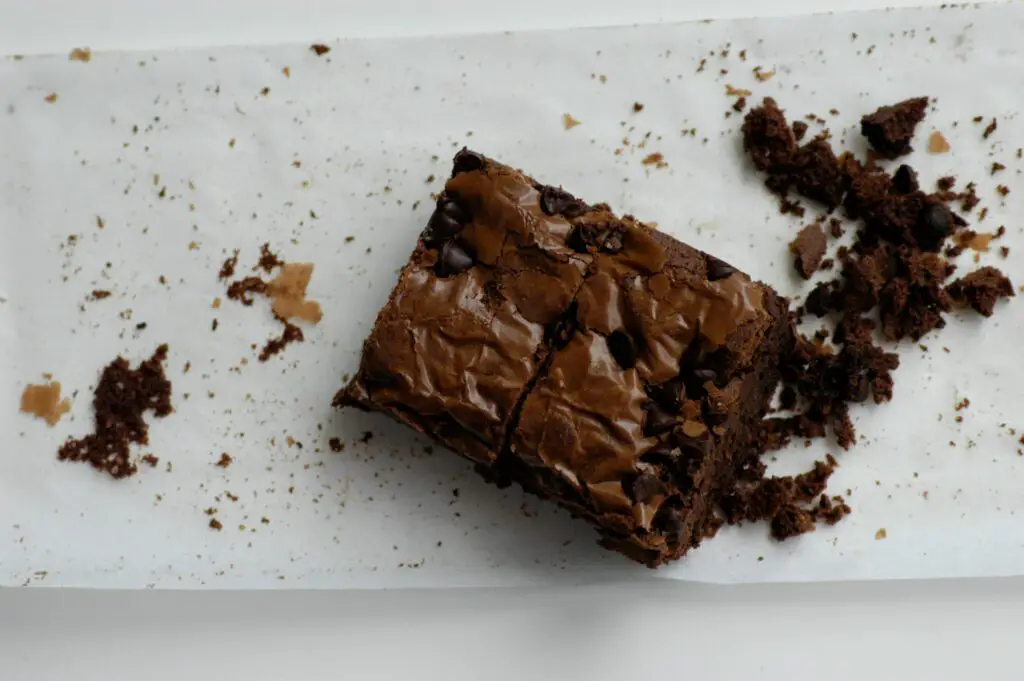Brownies are the kind of treat that can win over just about anyone. But let’s be honest—nothing’s worse than biting into one that’s dry, crumbly, or more like cake than brownie.
The good news? Getting that soft, chewy bite isn’t a mystery.
With the right ingredients and a few simple tricks, you can bake brownies that hit the sweet spot every single time!
The Science Behind Chewy Brownies
When it comes to brownies, texture is everything, and it all comes down to science.
Fudgy brownies are dense and almost truffle-like, chewy brownies strike that sweet middle ground with a firm bite and soft center, while cakey brownies lean toward the texture of—well—cake, light and airy but often missing that indulgent heft.
The real difference lies in the fat-to-flour ratio: more fat (butter or oil) and less flour give you fudgy richness, while a bit more flour tips the scale toward cake-like.
Chewy brownies, however, balance these two extremes by using just enough flour for structure without drying things out.
Sugar and eggs also play a big role because sugar keeps moisture locked in and adds that subtle chew, while eggs bind everything together and provide stability, with an extra yolk often being the secret weapon for chewiness.
Mastering these ratios means you can choose your texture destiny every time you bake, but if chewy is your goal, think balance, not excess.
Key Ingredients That Make the Difference
- Chocolate vs Cocoa Powder
- Chocolate: Using 6–8 ounces of melted semi-sweet or dark chocolate adds richness, moisture, and depth of flavor. It also contributes fat, which helps keep brownies soft.
- Cocoa Powder: Adding ½ cup of unsweetened cocoa powder delivers a stronger chocolate punch but can dry out the batter if not balanced with extra fat or sugar. Many chewy brownie recipes use both for flavor and texture harmony.
- Butter vs Oil
- Butter: ½ cup (1 stick) unsalted butter gives that classic flavor and a tender crumb. It makes brownies taste luxurious.
- Oil: ½ cup neutral oil (like canola or vegetable) creates a moister, slightly denser brownie with a longer shelf life. A mix of half butter, half oil often gives the best of both worlds—flavor and chewiness.
- Eggs
- 2 large eggs provide structure and stability.
- Adding 1 extra yolk boosts chewiness without making the brownies cakey. Yolks bring in fat and emulsifiers that help lock in moisture.
- Sugar
- Granulated Sugar: 1 cup white sugar creates that shiny, crackly top and adds sweetness.
- Brown Sugar: ½ cup light or dark brown sugar keeps brownies moist and chewy thanks to its molasses content. A mix of both sugars works wonders for texture.
- Flour
- Using ¾ cup all-purpose flour is just enough to bind the batter without tipping into dry or cakey territory. Overdoing it even slightly can make brownies tough, so measure with care.
Step-by-Step Brownie Making Guide
Step 1: Prepping the Pan and Oven (Temperature Matters)
Start by setting your oven to 350°F (175°C)—a sweet spot that cooks brownies evenly without burning the edges.
Line your pan with parchment paper and leave a little overhang on the sides so you can lift the brownies out cleanly.
Grease the paper lightly with butter or nonstick spray. Skipping this step is a rookie mistake; it makes removal a messy battle you don’t want.
Step 2: Melting Chocolate and Butter the Right Way
Always melt chocolate and butter gently. A microwave works if you heat in 20–30 second bursts and stir in between, but a double boiler gives you more control and prevents scorching.
If the chocolate seizes up, you’re left with grainy batter instead of silky smooth goodness. Melt until just combined—no bubbling, no burning, just glossy perfection.
Step 3: Mixing Technique (Don’t Overmix!)
Once your chocolate-butter mix is cooled slightly, whisk in sugar and eggs until smooth. This is where restraint comes in. Stir until combined, but don’t whip like you’re making meringue.
Overmixing incorporates too much air, which leads to cakey brownies. Think gentle folding, not an arm workout.
Step 4: Adding Dry Ingredients with Care
Sift together flour, cocoa (if using), and a pinch of salt. Add them to the wet mix in small portions, folding just until no streaks remain.
Too much stirring here develops gluten, which makes brownies tough. Less is more—treat the batter kindly, and it’ll reward you with tenderness.
Step 5: Baking Time – The Line Between Gooey and Overdone
Pour the batter into your pan and smooth the top. Bake for 25–30 minutes, depending on your oven.
Use the toothpick trick: insert one into the center; if it comes out with moist crumbs, they’re done. If it’s clean, you’ve gone too far.
Remember, brownies continue to cook a little after leaving the oven, so pull them early rather than late.
Step 6: Cooling and Cutting – Patience for the Perfect Texture
Here’s the hardest part—waiting. Let brownies cool completely in the pan before slicing. If you cut too soon, they’ll crumble and fall apart.
For clean edges, use a sharp knife warmed under hot water, then wipe it between cuts. Yes, it takes patience, but good brownies are like good stories—they’re best savored, not rushed.
Tips for Guaranteed Soft and Chewy Texture
Use Room Temperature Ingredients
Cold eggs or butter can throw your batter off balance. Room temperature ingredients blend more smoothly, giving you a uniform batter that bakes evenly.
Ever tried mixing cold eggs into warm chocolate? It scrambles faster than breakfast.
Let your eggs and butter sit out for 30 minutes before starting, and you’ll avoid lumps and uneven texture.
Avoid Overbaking (Toothpick Test Trick)
Overbaking is the fastest way to turn chewy brownies into dry bricks. Start checking at the 25-minute mark.
Insert a toothpick into the center—if it comes out with moist crumbs, you’re golden.
If it comes out clean, you’ve overshot. Remember, brownies keep cooking a little even after they leave the oven, so err on the side of underdone.
Let Them Cool Completely Before Cutting
I know the smell is irresistible, but cutting hot brownies is a recipe for a gooey mess. Cooling allows the brownies to set and lock in their chewy texture. Give them at least an hour.
For best results, cool in the pan on a wire rack, then lift them out using your parchment sling. Waiting may test your patience, but the payoff is neat squares instead of chocolate rubble.
Store Correctly for Maximum Softness
Once cut, store brownies in an airtight container at room temperature. They’ll stay soft for 3–4 days. Want to keep them longer? Wrap tightly and freeze for up to three months.
To get that “just baked” feel again, pop one in the microwave for 10 seconds. It’s like hitting rewind on freshness, and nobody complains about a warm brownie.
Creative Add-Ins for Chewy Brownies
Nuts (Walnuts, Pecans)
A handful of nuts can completely change your brownie game. Walnuts bring a slightly bitter crunch that balances the sweetness, while pecans add a buttery, mellow flavor.
Chop them into medium pieces so you get texture in every bite without turning the brownies into trail mix.
Toasting the nuts for a few minutes beforehand makes the flavors pop even more.
Swirls (Peanut Butter, Caramel, Cream Cheese)
Brownies are the perfect canvas for swirls. Drop spoonfuls of peanut butter, caramel, or cream cheese onto the batter, then drag a knife through for that marbled look.
Not only does it make the brownies gorgeous, but each slice ends up with a surprise flavor hit.
Peanut butter adds richness, caramel brings gooey sweetness, and cream cheese creates a tangy contrast that cuts through the chocolate.
Chocolate Chunks for Melty Pockets
Chocolate chips are fine, but chunks are better. Roughly chop a bar of semi-sweet or dark chocolate and fold the pieces into the batter.
When baked, they melt into pools of goodness that stay soft even after the brownies cool. It’s like finding treasure in every bite—gooey, rich, and slightly unpredictable.
Espresso Powder for Flavor Boost
A small spoonful of espresso powder won’t make your brownies taste like coffee—it just deepens the chocolate flavor. Think of it as turning up the volume on your chocolate.
Add about 1 teaspoon to your dry ingredients, and you’ll notice the brownies taste richer, darker, and more “grown-up.”
It’s a secret many professional bakers swear by, and once you try it, you won’t look back.
Troubleshooting Common Problems
Brownies Too Dry?
If your brownies come out dry, chances are they’ve spent too long in the oven or you added a little too much flour. Even an extra spoonful of flour can tip the scales toward cakey.
The fix? Always measure flour with the spoon-and-level method—don’t scoop straight from the bag. And keep a close eye during the last few minutes of baking.
Pull them out when a toothpick shows moist crumbs, not a clean stick. Remember, brownies will finish cooking a bit as they cool.
Too Gooey or Raw in the Middle?
A gooey center sounds dreamy, but if it’s still raw, that’s a problem. Usually, this means your oven is running cool or the pan is too small, making the batter too thick to bake through evenly.
Use an oven thermometer to check accuracy—many home ovens lie by 20°F or more.
And stick to the recommended pan size; using an 8×8 when the recipe calls for a 9×13 will throw everything off.
If the edges are done but the middle isn’t, tent the pan with foil and bake a few extra minutes to even things out.
Lacking Chewiness?
If your brownies are coming out more fluffy than chewy, the culprit is usually not enough sugar or eggs.
Sugar doesn’t just sweeten—it holds on to moisture, giving brownies their signature chew. Eggs, especially yolks, add fat and structure.
If your recipe feels too stingy with either, adjust by adding an extra yolk or swapping some white sugar for brown sugar.
That small tweak often makes the difference between “eh” brownies and the kind you can’t stop eating.
Final Words
Perfectly chewy brownies aren’t magic—they’re just the right balance of ingredients and a little baking know-how.
Once you’ve got the basics down, it’s easy to play around with flavors, swirls, or add-ins and still nail that texture.
Baked these? Share your chewy brownie pics—we’d love to see them!
FAQs
Can I make brownies without eggs?
Yes, but you’ll need a substitute to keep the texture right. Popular swaps include ¼ cup applesauce, mashed banana, or yogurt per egg.
These add moisture, but expect the flavor and chewiness to shift slightly. Flaxseed or chia “eggs” (1 tablespoon ground seeds + 3 tablespoons water) also work well.
Can I use whole wheat flour?
You can, but the brownies will be denser and less chewy. If you want the benefits of whole wheat without losing too much softness, swap only half the flour.
A 50/50 mix keeps them chewy while adding a little nutty flavor and fiber.
How do I store brownies to keep them soft?
Once cooled and cut, place them in an airtight container at room temperature. They’ll stay soft for up to four days.
For longer storage, wrap tightly and freeze for up to three months. To revive, microwave for 10–15 seconds to bring back that fresh-baked feel.
Can I double the recipe?
Absolutely, just use a 9×13 pan instead of an 8×8, and extend baking time by about 5–10 minutes.
Always rely on the toothpick test rather than the clock, since every oven behaves a little differently.



